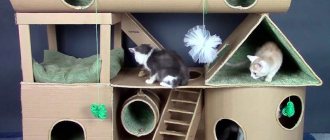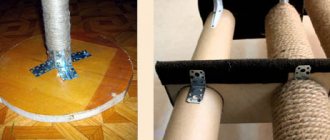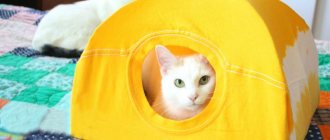6002Pavel
When keeping pets, there is often a need to perform certain procedures that require their immobility. If this is a cat, then he needs to trim his claws, get a haircut, perform medical procedures, for example, give injections. With all these procedures, it is important to know how to immobilize a cat correctly. After all, they are all stressful for the animal, which means it can behave completely unpredictably, injuring both itself and those around it.
To keep the cat from moving, it is not necessary to use sedatives or other tranquilizers; you can get by with another working method.
© shutterstock
How to immobilize a cat?
When keeping pets, there is often a need to perform certain procedures that require their immobility.
If this is a cat, then he needs to trim his claws, get a haircut, perform medical procedures, for example, give injections. With all these procedures, it is important to know how to immobilize a cat correctly. After all, they are all stressful for the animal, which means it can behave completely unpredictably, injuring both itself and those around it. To keep the cat from moving, it is not necessary to use sedatives or other tranquilizers; you can get by with another working method.
How to clean a cat's face?
It is better to wipe the face with a damp sponge without using shampoo. Use special washing products, these are various shampoos for cats or kittens. Products for people, even children, are under no circumstances suitable, as they have inappropriate acidity (pH) and can irritate the animal’s skin.
Interesting materials:
What spices does carp like? What spices does salmon like? What canning methods are used to preserve food for the winter? What methods of cutting vegetables are used in cooking? What reference materials will be available on the exam in mathematics? What are the moon's satellites? What are the stages of alcoholism? What power supply standards exist? What are the VAT rates? What are the best steaks?
How to immobilize a cat: tips for beginners
To painlessly immobilize a cat, you need to use these tips::
- check the cat’s reaction to how you want to immobilize him;
- pre-wash your hands under clean water, possibly using non-scented soap, so as not to cause an unnecessary reaction from the cat;
- you can purchase special clips for cats, which are designed in accordance with the anatomical structure of the animal’s body;
- if both at the initial stages and during the process of immobilization the cat shows aggression, you should immediately abandon this method;
- no need to lift the cat by the scruff of the neck. If, nevertheless, the action is very important to perform, then it should be supported from below, for example, under the hind legs.
Typically, a cat is wrapped like this:
- A towel is laid out on the table. The cat, taken by the scruff, is placed in its middle.
- While continuing to hold the cat with one hand, the other hand throws part of the towel over the cat's back and tucks it under its side. In this case, the fabric is stretched quite strongly.
- The other half of the towel should then be wrapped around the cat and only when it is tucked under the cat's body can the scruff of the neck be released. If the cat does stick its paws out from under the towel, then it will need to be pulled tighter.
If you find an error, please select a piece of text and press Ctrl+Enter.
Preparing a cat for immobilization
There is a really workable option to immobilize a cat with a clothespin or a paper clip - essentially the same thing. The item is attached to the withers without causing pain or discomfort for the cat. Behavior is inhibited spontaneously and reactions are slowed down. The cat will better tolerate this procedure, provided that it is performed by a person close to him, or better yet, by the owner. Also, manipulation should be carried out only in case of urgent need, and not for fun.
Most cats that were tried to be immobilized in this way experienced the action positively, without pain or fear. But no one is immune from the individual reaction of each individual cat.
First you need to prepare the cat for the procedure:
- If the pet is wearing a collar, it must be removed to provide free access to the cat's neck. If left on, it can create a suffocating feeling and your pet will become agitated.
- After this, you need to find the scruff. It is located on the outside of the cat's neck and looks like a loose fold. If it is difficult to feel the cat’s scruff, then it will not be easy to immobilize it. You should be extremely careful not to squeeze your cat's skin too hard.
- You need to grab the scruff of the neck with your hand and look at the pet’s reaction. If he feels completely relaxed, then he can quickly be immobilized. If the animal meows or tries to escape, then you need to try to immobilize it using another method.
You can determine that a cat is tense when he is not trying to escape by dilated pupils, intermittent breathing, and moving ears. If you grab it by the scruff of the neck closer to the ears, you can control the movement of the animal’s head. To avoid needing help when immobilizing a cat, it is better to watch a training video in advance. It's actually simple.
How to pick up a cat
The cat should be picked up under the chest with both hands. Raising your chest, you should press the back of your chest to the side of your body, right under your elbow. Then you should change the position of this hand and grab the cat under the chest with your palm, and then squeeze the animal’s front paws with your fingers. After this, the second hand will be free. When you pick up a cat in this way, you should definitely scratch its neck, which will calm it down a little. If the cat tries to escape, then by taking it in this way you can grab it by the hind legs.
An effective method to immobilize a cat
The process of immobilizing young healthy cats includes the following steps::
- Attaching a clip to the cat's scruff . You need to select a clothespin or clip approximately 5 cm in size and place the device on the withers directly behind the ears. Each owner can choose what exactly to pinch the scruff of the neck on their own. You need to look at the cat’s reaction to see what suits him best. If a paper clip puts too much pressure on the skin, the cat will not tolerate the pain.
- It is necessary to place the pet on its side . Since the cat relaxes too much after the clamp, he may involuntarily fall on his own. If this does not happen, you can gently press on the hind legs to remove resistance. You can tell that the cat is completely relaxed by his behavior. He tends to pull the lamps towards his muzzle, curls up into a ball, and places his tail between his paws. If the cat cannot be laid on its side, it continues to stubbornly stand on its feet and tucks its tail, which means it is not calm and is very scared.
- Using additional clothespins . The reception will help to completely relax the animal. To do this, several clamps must be placed a little further than the first one on the back of the neck along the spine. If the cat starts to get violent, then all the clamps need to be removed.
- Also, the method of placing a clothespin anywhere along the back along the spine may work for some cats, but greater effect can only be achieved when placed on the neck.
- After a few minutes, the clothespins need to be removed . However, the duration of the resulting peace of mind is sometimes completely unpredictable and is determined on an individual basis. Some cats are immobilized during the entire grooming and nail trimming procedure, while in other cases the animal can be deactivated for a short period of time.
Where does the “fading effect” come from?
When the kitten is still very small, the mother cat takes it by the neck with her mouth and carries it to a safe place if something threatens it.
At this moment, the kitten must be motionless because its life is at a critical stage. This has been fixed genetically over hundreds of years. Even after the kitten grows up, this reaction will accompany him throughout his life.
Don't be surprised if your pet immediately becomes quiet as soon as you pick him up by the scruff of the neck. It is believed that the animal has many nerve endings on its neck, and this gesture causes him severe pain. Like, that's why he becomes motionless. This is not entirely true. Although grabbing a pet by the scruff of the neck is really unpleasant, so it is better not to do this unless absolutely necessary.
Dry shampoo is the way out
So, the owner decided that bathing the cat is an objective necessity, but the animal does not let itself be handled, bites, scratches and protests against water procedures in every possible way. What to do?
The way out is to use dry shampoo. Even though the effect of such a procedure is not comparable to the cleanliness after washing, treating the fur with this product gives cats less discomfort than bathing.
The powder from the bottle is applied to the animal’s fur coat directly with your hands, making massaging movements with your fingers. After this, so that the product is distributed evenly, the pet is combed. There is no need to wash off the powder with water.
It is important to take precautions when working with dry shampoo. Firstly, the procedure should be carried out in a room where the floors can be washed (it is almost impossible to remove spilled cleaning powder from the carpet without damaging the latter). Secondly, use the product no more than once every six months. Otherwise, the animal will develop an allergic reaction to the shampoo. This leads to a logical disappointing conclusion: dry cleaning products are not a panacea, and sooner or later the cat will have to be washed in the traditional way.
Interesting experiment
Neuroscientists from universities in the USA and Japan conducted an experiment. They selected 31 cats of different sexes, ranging in age from 1 to 5 years, and clamped clamps on their necks. It was discovered that no matter what the cats did, they immediately stopped moving and arched their backs. They then placed the tail between the legs.
During this time, the cats did not have dilated pupils, their heart rate did not increase, and they did not breathe too quickly. Obviously, this situation refers to the normal physiological state of the cat, and not to its fear or painful shock. Scientists have given this condition a name: the phenomenon of behavioral inhibition caused by entrapment.
Besides cats, there are many other creatures that react this way to scruff grabbing, including rabbits, mice, dogs, pandas, and even lions and tigers. This is a natural reflex that comes from early childhood, when the mother carries her cubs to save their lives.
Now you know how to quickly calm your cat down for a while or hold him if necessary, but do not overuse this technique.
Source
conclusions
- The clothespin allows you to secure the cat during nail trimming or veterinary procedures;
- The pet stops moving due to a reflex that allows cats to carry their babies;
- You can use any clothespin from five millimeters, but it’s better to use a special one bought at a pet store;
- You can restrain your cat both at home and at a groomer’s appointment or at a veterinary clinic;
- Not all cats are loyal to being fixed with a clothespin; check your reaction in advance.
When using materials from thebestvideo.ru, a link to the source is required.
Why you can't drag a cat by the scruff of the neck
Thanks to the innate reflex, the kitten, when the mother cat drags it, grabbing it by the scruff of the neck, relaxes its body, and also tucks its hind legs and tail. Temporary paralysis is explained by pinching of a bundle of nerves located on the back of the neck. It is much easier for a cat to move a relaxed and non-resisting baby to a safe place. During carrying, the cat does not cause any harm or pain to its cub. The scruff of a cat's neck is considered the most painless part of the body. However, adult pets cannot be lifted or dragged by the scruff of the neck.
Cats drag kittens, biting the scruff of the neck with their teeth
Video: how to turn off a kitten
Reasons are physiological
The ban on lifting an adult cat by the scruff of the neck is explained by physiology:
- A mature animal's skin is rougher and less elastic than that of a small kitten. The skin does not stretch well and may even tear.
- The neck muscles may become damaged (stretched or torn), since the pet is already quite heavy.
- The rough skin becomes very tight and puts pressure on the throat, making it difficult for the cat to breathe.
- A sharp grab by the scruff of the neck can even damage the spine (in rare cases).
In an unusual position, some individuals panic, break out and scratch themselves badly. At the same time, they cause physical harm not only to the person who grabbed them, but also to themselves.
In principle, it is impossible to take a big cat by the scruff of the neck.
Our previous cat was small and puny. He was constantly playing dirty tricks, and that’s why they often dragged him by the scruff of the neck. This did not cause him any visible suffering. The current cat is distinguished by good quality and fatness. It is not easy to grab her by the scruff of the neck, and besides, these actions clearly cause severe pain to the cat.
How to properly pick up a cat by the scruff of the neck
However, in some situations it becomes necessary to grab the cat by the scruff of the neck . This will be required, for example, when performing hygienic procedures (trimming nails, combing, etc.) or at an appointment with a veterinarian. If you grab the scruff of the neck correctly, this will calm and limit the animal’s movements, but will not cause him discomfort or pain.
In emergency situations, for example, when rescuing the cat, you need to grab it by the scruff of the neck
- The collar must be removed (if there is one), since, unlike the skin on the scruff of the neck, it does not stretch at all. A cat can be accidentally strangled.
- The pet is placed on a flat, stable surface (table or floor), from which it will be easier to pick it up.
- Place the palm on the back of the neck and grab the loose skin on the back of the neck, closer to the ears. You need to take as much skin as possible (feeling for a good fold).
- Carefully lift the cat, holding it by the scruff. A heavy specimen needs to be supported with a second hand.
- At the end of the procedure, the cat is returned to its place and only then the skin is released. You should stroke and praise the sufferer and treat her with a treat.
It is important to grab the cat by the scruff of the neck correctly
You should not pick up a sleeping or overly excited cat by the scruff of the neck, or when he is eating.
Video: how to restrain a cat
Freedom-loving cats do not tolerate violence against their own personality, so unless absolutely necessary, it is better not to pick them up by the scruff of the neck, especially older or elderly pets.
Source
How to properly pick up and hold a cat in your arms so as not to cause inconvenience to the animal?
How many cat owners, when picking them up, think about the fact that their inept actions could cause them discomfort, and in some cases, harm? Meanwhile, you need to be able to do it correctly. To ensure that the pet does not break free, calmly walks into the owner’s arms and gladly receives affection from him, you need to take into account several nuances. Each owner of such a pet is recommended to know not only how to properly hold a cat in his arms, but also how he should be picked up from the floor and what actions should be avoided.
Bathing and grooming bag
It is also called a bathing net, a bathing bag, or simply a cat swimsuit.
It is useful not only for water procedures, but also for other hygiene measures, as it allows you to partially immobilize the animal.
How to bathe a cat in such a bag
First you need to prepare for water procedures. Add shampoo to the container of water where you will wash the cat and whisk it until foamy. Then place the animal in the net and secure it with strings (laces), first on the neck, and then on the rest.
Material: 100% polyester. Size range – for small cats and kittens (S), for medium sizes (M), for large cats (L).
Well, let's look at the last clamp.
How to pick up a cat?
It would seem that what is so difficult about picking up a pet? However, not everything is as simple as it seems at first glance. If you pick up a cat from the floor incorrectly, it can become very nervous and break free, injuring its owner. Following the following sequence of actions will help you do this correctly:
- Approach the animal calmly and slowly. At the same time, you should not make sudden movements so as not to scare the cat. It is also recommended to make sure that the pet is in a good mood and is ready for close contact with the owner.
- Affectionately call the cat by name.
- Pet the cat, scratch him behind the ear.
- Place one hand under the animal's body behind the front legs, take the other hand, holding it by the hind legs, and carefully lift it. It is recommended to do this only after the pet relaxes during the petting process and purrs, showing pleasure from gentle words addressed to itself. It is generally not recommended to handle kittens under 1 month of age. Pets aged 1 to 6 months are picked up, holding one palm under the belly and the other under the butt. The tail must be carefully placed between the hind legs.
- Carefully hold the cat close to you so that he feels the warmth emanating from the owner and understands that he is completely safe.
Safety precautions
You should not make the mistake of thinking that if a cat is very calm and docile in its normal state, then it will be just as calm when it is sick or in severe pain. The same can be said about taking especially nasty-tasting pills that can unbalance even a very calm animal. You should never put yourself at unnecessary risk by giving your pet medication without trying to hold it back. It's even worse when the cat is approached face-first without any restraint. We should not forget that cat bites and scratches are quite painful and can cause serious illness. Because of this, being safe is much better than being careless. If a cat scratches or bites its owner, then he should definitely consult a doctor.
How should you keep your pet?
You also need to know how to hold your pet correctly. It is recommended to follow the following rules:
- Place the animal near the chest so that its head is slightly higher than the level of the body.
- Gently hold the cat close to you, avoiding too much squeezing. Excessive pressure will not only cause her discomfort, but can also cause pain, and in some cases lead to injury, especially if we are talking about a kitten whose skeletal system has not yet fully strengthened.
- Make sure your pet's body is straight. It is not recommended to allow the animal's body to sag and place it upside down. An uncomfortable position will cause the cat, experiencing discomfort, to begin to violently break free from your hands. If you don't let her go right away, she can bite and scratch her owner.
This terrible word "narcosis"
In fact, another term has long been used in medical practice - “anesthesia”. General anesthesia (anesthesia itself) is a state of deep sleep of an animal with complete loss of all sensitivity. Such anesthesia is necessary for serious painful operations; it saves the animal not only from suffering, but also from death due to painful shock.
There is also local anesthesia - this is a loss of sensitivity in certain areas of the body. Local anesthesia is divided into 8 types depending on where exactly the intervention should be performed.
Horrible stories about anesthesia will be passed on from mouth to mouth by more than one generation of pet owners. Let’s say right away (have the courage to bear this “news”) - there are no completely harmless anesthesia drugs. Nowhere.
However (here you can exhale) the harm of anesthesia is sometimes greatly exaggerated. Indeed, some drugs have a toxic effect on the liver and disrupt the functioning of the heart muscle. First of all, these are chloroform and phlorotane. The first one was banned for use a long time ago due to its high toxicity. The second is not used in veterinary medicine. All other drugs currently used do not have significant harmful effects on the liver and heart.
But still, the concept of anesthetic risk is not a myth. Under the influence of anesthesia, the heart rate accelerates or slows down, blood pressure decreases or increases (depending on the drugs used), body temperature decreases, metabolic processes slow down, and breathing becomes less frequent. All these changes can provoke the manifestation of various pathologies. For example, compensated heart failure, unnoticeable in an animal while awake, under anesthesia can complicate the functioning of the heart. In addition, an allergic reaction may occur to anesthetic drugs (like any other).
The older or, conversely, younger the animal, the higher the risk. Naturally, it also increases in sick, weakened animals. Therefore, as always and everywhere, everything depends on the qualifications of the doctor. Only he can assess the degree of risk, choose the appropriate drug, and carry out resuscitation measures, if necessary.
To finally reassure you, let's say that now the risk is, according to statistics, one death per more than a thousand operations.
How to release an animal?
Typically, cats do not like to be in the arms of the owner for a long time, and even if you correctly pick up and hold the pet in your arms, after some time he will want to be free. This does not mean that the animal dislikes its owner. This behavior is caused by animal instincts, which dictate to representatives of the cat family the desire for the most free existence.
If your cat starts to get restless and fidget, it's time to put her down on the floor. It is not recommended to hold your pet by force. It is also forbidden to try to do this by shouting. It will begin to escape from your hands, and if claws and teeth are used, it is unlikely that you will be able to avoid injury. Moreover, the animal may lose trust in its owner and subsequently begin to reject any attempts to pick it up.
It is forbidden to throw the cat or let go too abruptly. In the first case, the animal, especially a kitten, can be injured. When a cat is suddenly released, it can release its claws, leaving deep wounds on the owner’s hands.
When should you not pick up a cat?
It is not always possible to pick up a pet. To do this, it is recommended to seize a convenient moment. You should not try to hug a cat when she:
- Too busy. It is not recommended to distract your pet from playing or watching birds outside the window. An excited or enthusiastic animal is unlikely to want to be distracted from an interesting activity. If you try to pick it up, it will squirm furiously, using its claws and teeth.
- Dozing or sleeping. A pet, torn from Morpheus's embrace, is unlikely to appreciate attempts to embrace him.
- Hunts. Hunting for representatives of the cat family is considered an extremely important activity, and even if its object is a sunbeam or a fly, the animal should not be distracted.
- Fights with brothers or other domestic or street animals. Trying to snatch a cat from a fight is a huge mistake on the part of its owner. Instead of a cute pet, you will find an angry creature in your arms, which, in its enraged state, is capable of causing serious injuries to its owner.
- Eating or washing. Just like hunting, cats treat food intake and hygiene procedures with special trepidation. You can pick up your pet only after he has finished eating and washing himself.
Kittens need to be accustomed to such close contact from an early age. To do this you need:
- encourage your four-legged baby with a treat after he is in your arms;
- stroke and caress your pet as often as possible in order to develop in him an understanding that the owner’s hands are not fraught with danger;
- teach a kitten to fall asleep in a hug - close contact with a person will be associated with comfort, calm and safety;
- Don’t shoo the baby away when he asks to be held; it’s usually enough to spend a few minutes with him.
Source
At what age can a cat's nails be trimmed?
It happens that the claws grow back by 6-8 weeks so that the kittens scratch their mother when feeding. However, in most cases, the need for a “manicure” occurs by three months, or 15 weeks. First strong claws
are formed in
a kitten
in the fourth month of life, and are fully formed by six months.
Interesting materials:
Is it possible to get a denture if there are no teeth? Can I take Theraflu while driving? Is it possible to give birth if you have ureaplasma? Is it possible to drive if you are not covered by insurance? Is it possible to eat broccoli when it is in bloom? Is it possible to find out your browser history if it has been deleted? Is it possible to find out who asked the question on Instagram? Is it possible to find out who to ask questions on Instagram? Is it possible to pick up an electronic cigarette from the post office if you are under 18 years old? Is it possible to get married if there is no divorce stamp?











